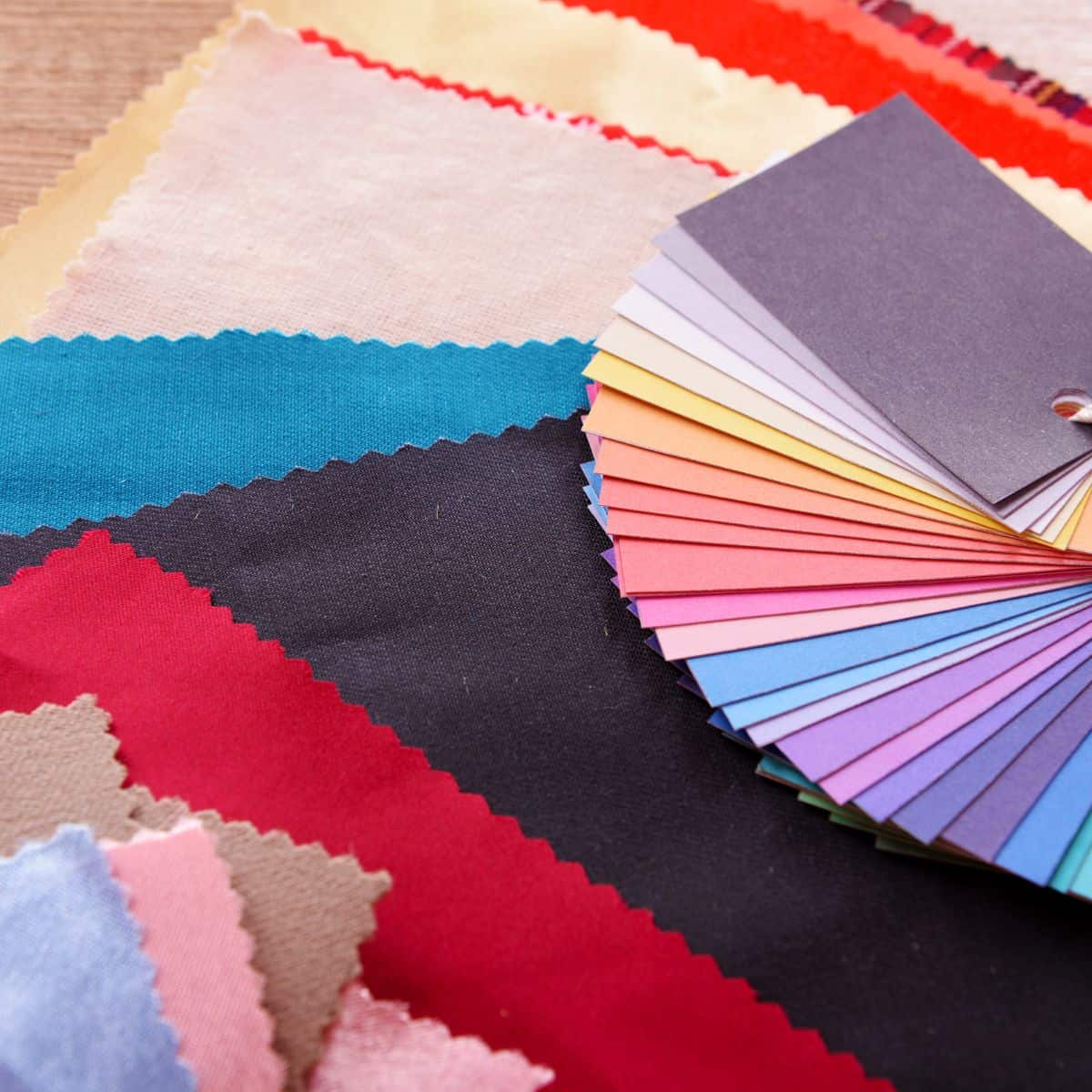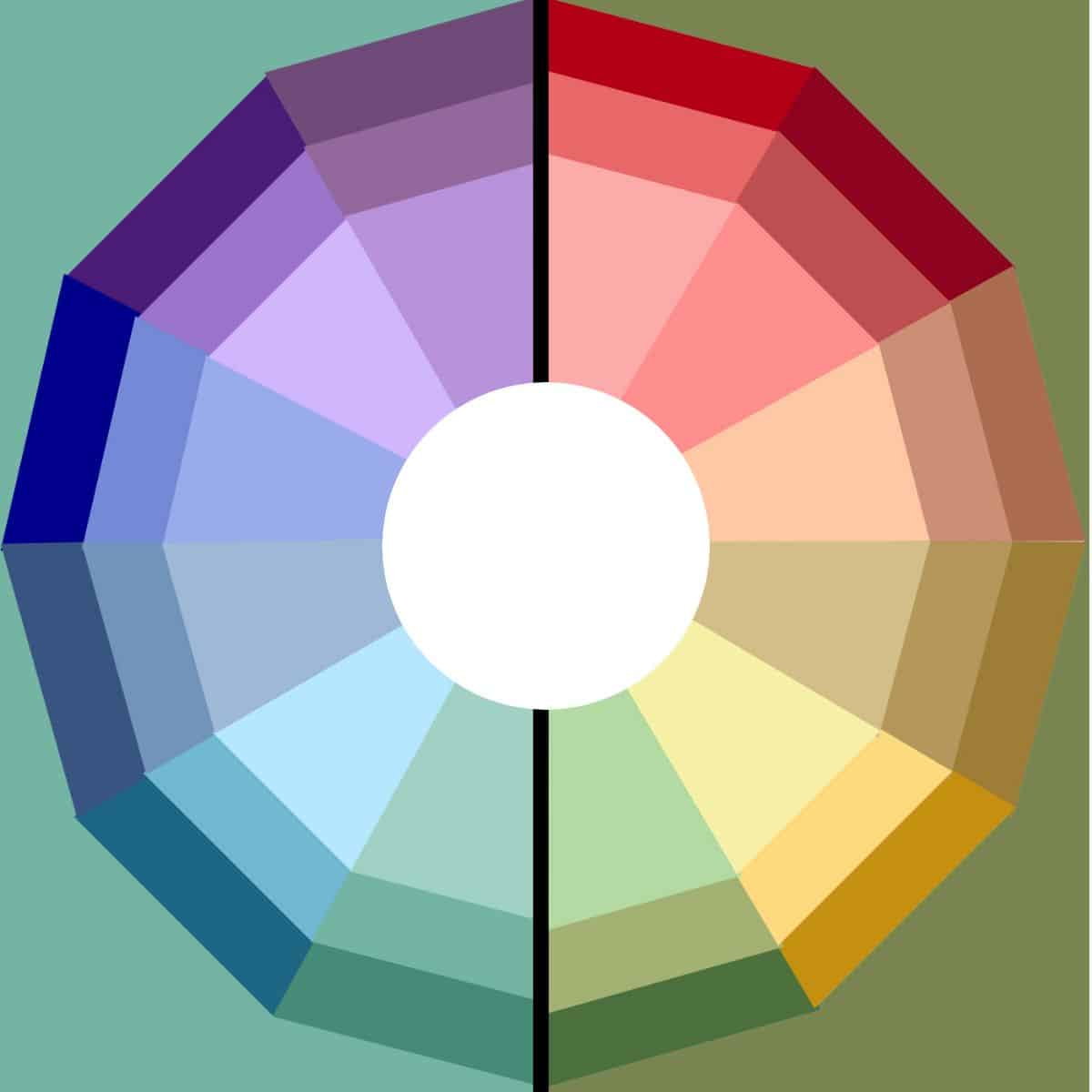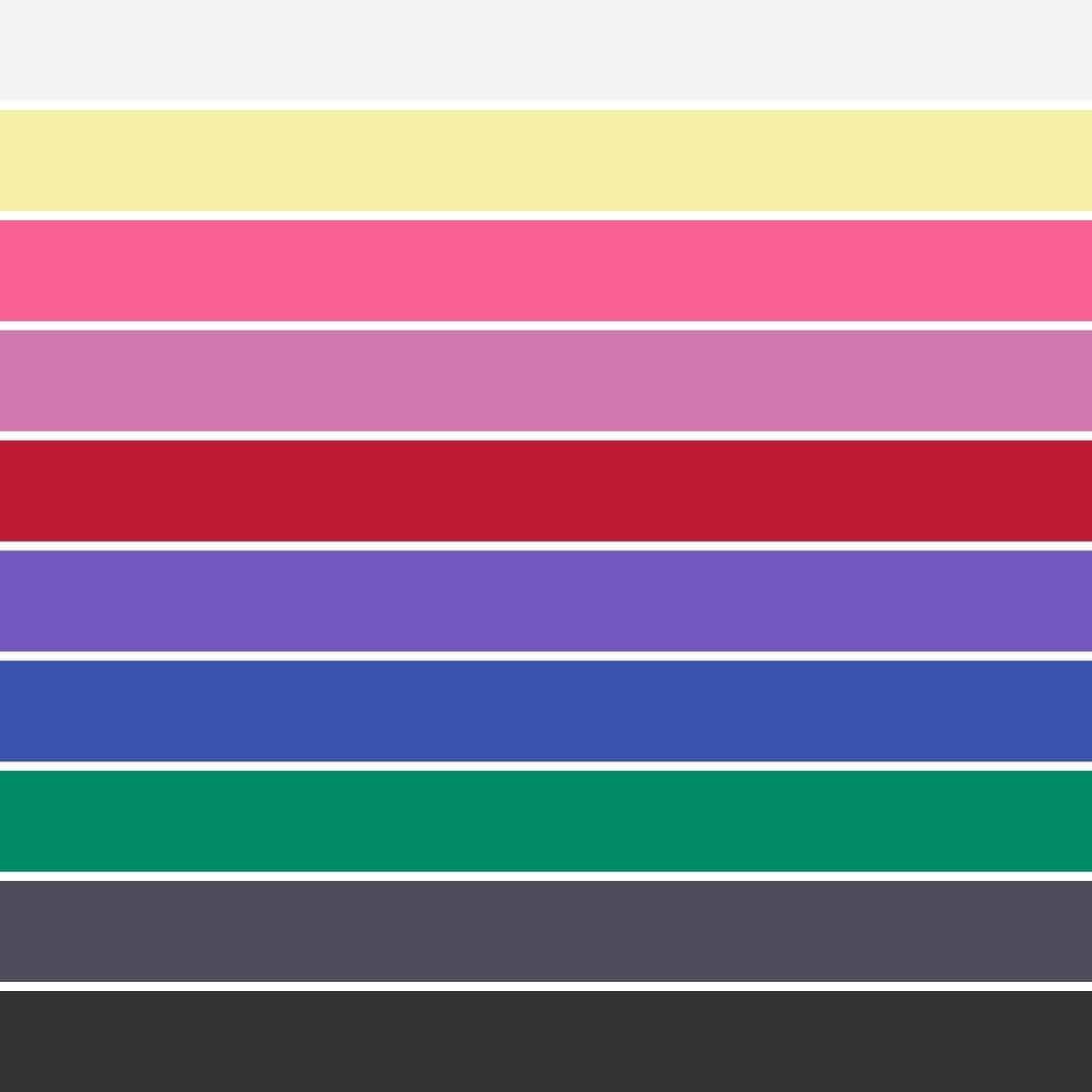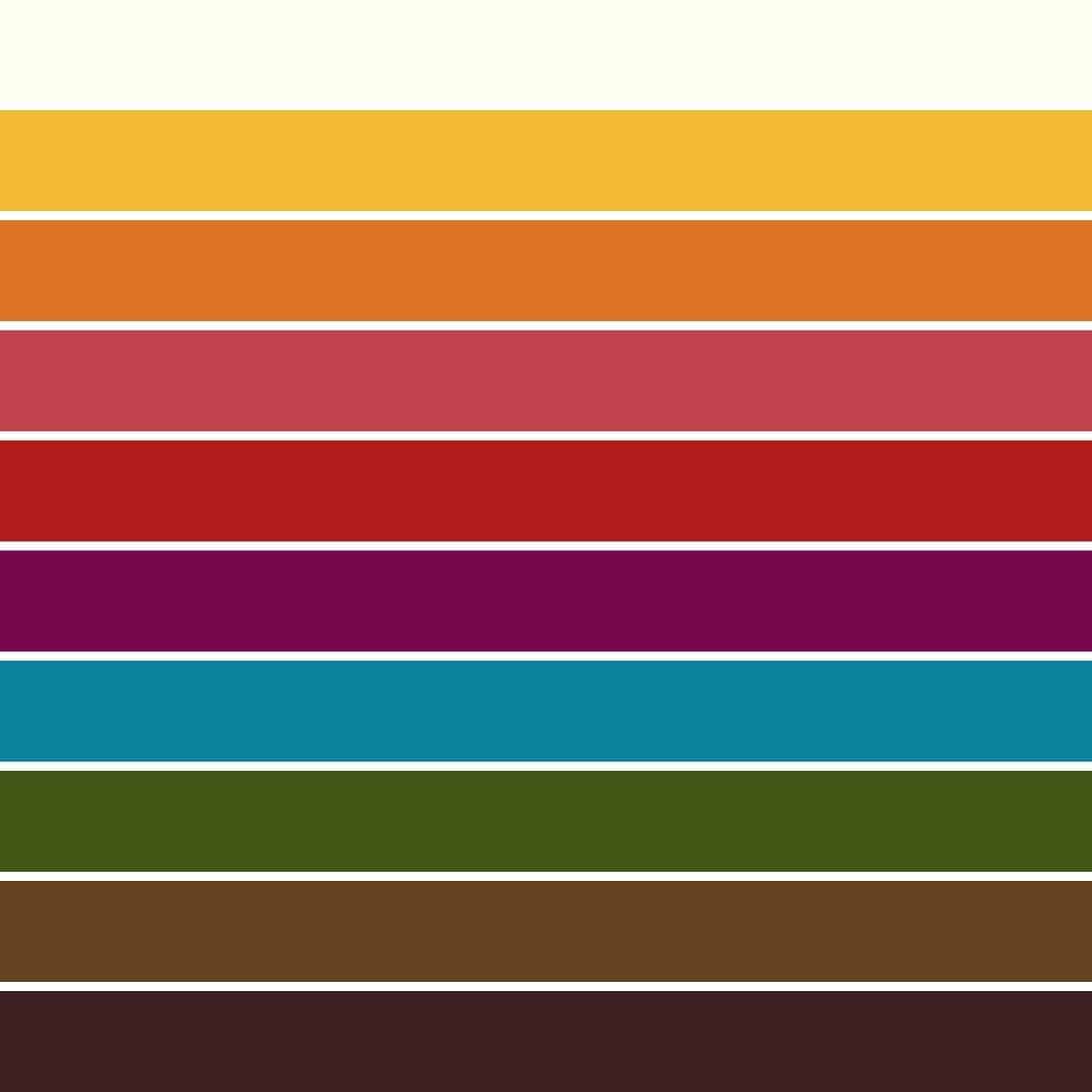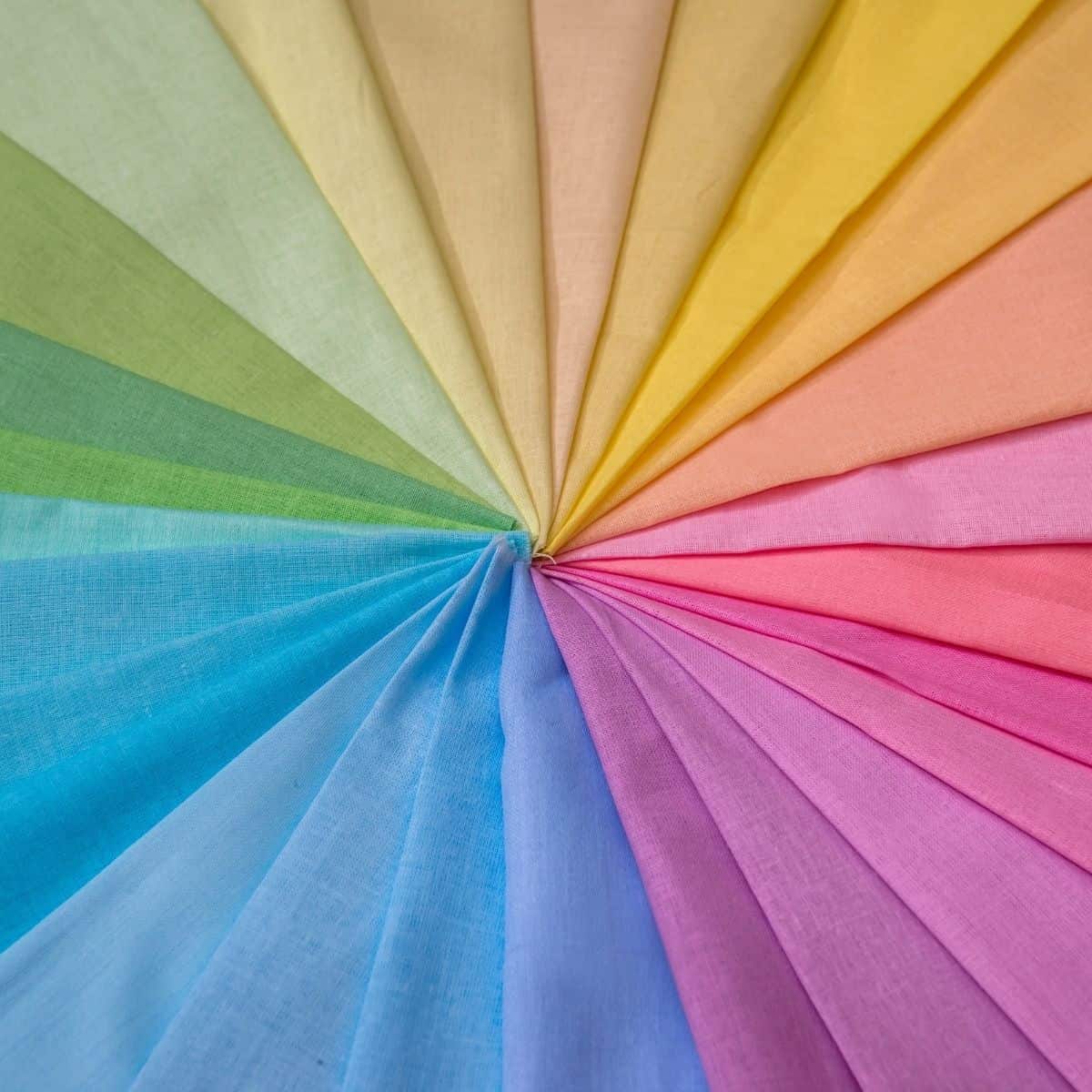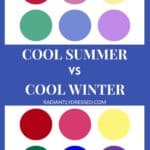Cool Summer vs Cool Winter: Discover the Difference between the Cool Seasons
Curious about the difference between Cool Summer and Cool Winter? Find out how to identify your color season and why it matters.
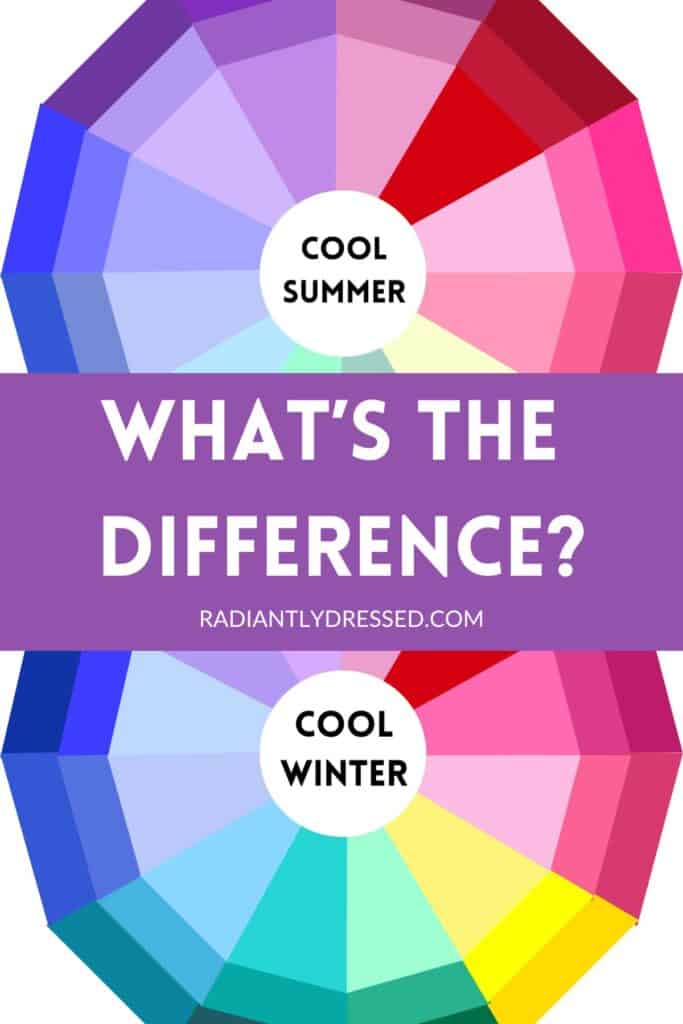
Here we are at the end of our series focusing on the 6 tonal seasons. As we end again with a winter season, I’m struck by how this is another one of the ones I would categorize as most common/difficult.
Cool Winter and Cool Summer can often be confused with each other, as there is quite a bit of crossover between these seasons. However, there are a few ways to definitely tell them apart, such as value and contrast level.
The cool summer season features individuals with an overall cool complexion; typically, you might see lighter skin tones, hair that ranges from medium ash brown to lighter shades, and eyes that may be blue, green, or gray. Your look is often best complemented by soft, muted colors, avoiding anything too warm or excessively bright. This cool, subtle palette serves to frame your delicate coloring without overwhelming it.
On the other hand, if you identify with the cool winter season, your skin, hair, and eyes have cool undertones, but can carry greater contrast and intensity. As a cool winter, you are likely to have anything from light to dark skin, with potentially stark eye color contrast and deeper hair tones. Jewel-toned apparel and bold hues align with your profile, enhancing the natural contrast between your features and enabling you to wear bright, intense colors confidently.
Table of Contents
Understanding Color Seasons
In the realm of color analysis, ‘cool summer’ and ‘cool winter’ are terms that describe two distinct color seasons which are part of a categorization system used to determine the most flattering colors for an individual based on their natural coloring. Understanding these two seasons is crucial because they can guide you to select colors for your wardrobe and makeup that enhance your natural beauty.
Cool Summer characteristics include:
- Value: light to medium colors
- Contrast: muted and pastel tones
- Best Colors: soft pastels – sky blues, soft roses, and cool grays
Cool Winter traits are:
- Value: medium to dark colors
- Contrast: highly saturated and bright
- Best Colors: vibrant blues, rich purples, and icy colors with a clear, vivid quality
By understanding your color season, you can enhance your wardrobe and makeup choices, ensuring that they flatter your natural coloring. Remember, the best hues for you are those that reflect your inherent tones, creating a harmonious and balanced look.
Characteristics of Cool Summer
The Cool Summer color palette is defined by its harmonious, subtle, and cool hues, ideal for creating an elegant and understated look.
Color Palette of Cool Summer
Your Cool Summer color spectrum encompasses soft, muted colors that maintain a cool undertone. These hues lean towards pastels and are less intense than the vibrant shades of Cool Winter.
- Blues: Sky blue, periwinkle, and powder blue
- Greens: Jade green, dusty teal, and mint
- Pinks: Soft rose, lavender blush, and mauve
- Purples: Lilac, cool amethyst, and soft violet
- Neutrals: Cool grays, subtle navy, and soft whites
To integrate these colors into your wardrobe, begin with the neutrals as your foundation and intersperse the primary and secondary colors for a balanced, harmonious look that resonates with your Cool Summer characteristics.
Characteristics of Cool Winter
The Cool Winter color palette is known for its bold and high-contrast hues. Your wardrobe, makeup, and fashion accessories benefit greatly from the inclusion of vibrant, saturated colors that enhance your natural features.
Color Palette of Cool Winter
Your Cool Winter palette includes colors that are rich, intense, and very cool. Here’s a concise listing of the types of hues you should look for:
- Blues: Sapphire, Navy, Icy Blue
- Greens: Emerald, Pine
- Purples: Amethyst, Royal Purple
- Reds: True Red, Burgundy
- Pinks: Hot Pink, Icy Pink
- Neutrals: Black, White, Charcoal Gray
Remember, your colors should feel like a natural extension of the icy contrasts of winter time, and be in alignment with your Cool Winter palette.
How to Distinguish Cool Summer vs Cool Winter
Variations in Value
Cool Summer and Cool Winter both feature some colors that sit in the medium range, neither extremely dark nor very light, which can often lead to some confusion. For instance, both seasons might use shades of cobalt and royal blue. However, understanding their differences in value can clarify which season you might lean towards.
Cool Summer typically suits a medium-light spectrum, meaning their ideal colors are neither too deep nor too bright. This season is often overwhelmed by deeper shades unless they are significantly muted, like a soft burgundy.
On the flip side, Cool Winter thrives in a medium-deep value range. Pastels and other light colors often wash out Cool Winters unless these hues are icy or nearly white, giving them a sharp, crisp appearance.
These differences in how light or dark colors can appear are crucial for accurately determining whether you’re a Cool Summer or a Cool Winter. Recognizing whether you flourish in softer, lighter shades or more pronounced, deeper ones can guide you in curating a wardrobe that truly reflects and enhances your natural coloring.
Contrast and Intensity
While contrast is a defining feature in distinguishing between Cool Summer and Cool Winter, it can often be subtle and complex to discern. Cool Summer is considered brighter than other Summer seasons due to a secondary influence from Winter, making its colors more vivid. Conversely, Cool Winter displays a softness uncommon to Winters, attributed to a secondary Summer influence.
To better understand these nuances, let’s explore the distinction between pastel and icy colors. Pastels are created by diluting a color with white or gray, which naturally reduces the color’s saturation and intensity. This gives pastels a soft, muted appearance. On the other hand, icy colors resemble the vibrant yet light hues you’d see in a frosty lemonade at a theme park. These colors are light, like the yellow of a frosted lemonade, but they retain a crystal-clear vibrancy, unlike the creamy, subdued yellow of lemon meringue pie.
This concept of contrast applies across all color families. For example, compare the subdued richness of ruby with the bold brightness of true red, or the gentle tones of bubblegum pink against the vividness of shocking pink.
When determining your best fit between these seasons, consider how you react to different types of colors:
- Do pastels wash you out, making you appear dull or faded?
- Do you thrive in the clarity and brightness of icy shades, which bring your features to life?
Answering these questions will help you identify whether Cool Summer’s subdued tones or Cool Winter’s vivid contrasts suit you better, guiding you towards a wardrobe that enhances and complements your natural coloring.
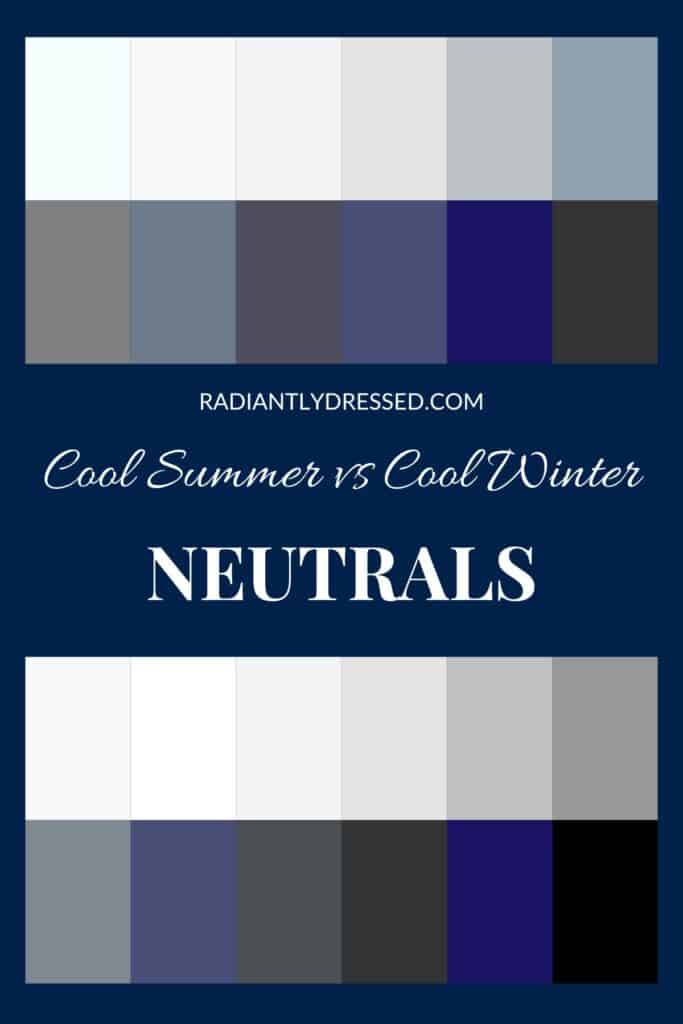
Summer and Winter Neutrals
In the intricate process of color analysis, neutrals often provide the definitive answers when distinguishing between Cool Summer and Cool Winter, especially when value and contrast do not present clear distinctions. Over the course of conducting more than 100 color analyses, I’ve discovered that draping in neutrals can be highly revealing.
For Cool Summer types, gray stands out as an essential neutral. It not only complements their coloring but also resonates with their aesthetic preferences. Additionally, true navy serves as an excellent neutral for Summers, providing depth and sophistication without overwhelming their softer characteristics.
In contrast, Cool Winter types often find gray challenging. They typically avoid it as it rarely harmonizes with their sharper, more defined features. This aversion to gray highlights a crucial aspect of Winter’s palette; Winters struggle to find a gray that enhances their look, indicating that it’s not aligned with their seasonal characteristics.
The test of black and white, the epitome of high contrast, further clarifies this distinction.
Only Winter types can wear black and white without it appearing overly harsh. These colors can intensify lines and skin unevenness in Summer types, often making them look less vibrant. On the other hand, black and white create a striking backdrop that makes Winter faces pop, accentuating their natural contrast beautifully.
For Summer types, navy and gray provide a skin-smoothing effect. These neutrals enhance their natural coloring, offering a soft yet defined appearance that aligns perfectly with the gentle vibrancy of the Cool Summer palette.
By understanding how different neutrals interact with your natural coloring, you can more effectively determine whether you lean towards the Cool Summer or Cool Winter season, ensuring that your wardrobe supports and enhances your inherent beauty.
Color Test: Cornflower vs Cobalt
To effectively determine whether someone belongs to the Cool Summer or Cool Winter color season, conducting a drape test with two specific shades of blue can be very insightful. This test involves comparing how a person looks when draped in different tones within the same color family.
For Cool Summer, the suggested color is cornflower blue, a soft, light shade of cool blue that includes a significant amount of gray and white. This hue epitomizes the subdued and gentle aesthetic typical of the Cool Summer palette. When Cool Winter types are draped in cornflower blue, their skin might appear pasty or sickly. This color is too muted and light for their vivid characteristics, failing to complement their natural contrast.
Conversely, for Cool Winter, cobalt blue is recommended. This is a striking, vivid blue that almost has a neon quality. It is intense and vibrant, aligning well with the bold and clear color needs of Cool Winter individuals. When Cool Summer types are draped in cobalt blue, the color tends to overwhelm their features. The brightness of the cobalt makes the color stand out too much, causing their features to recede and become less noticeable.
This blue drape test can help pinpoint whether you are a Cool Summer or Cool Winter, guiding them towards colors that truly enhance and complement your natural beauty.
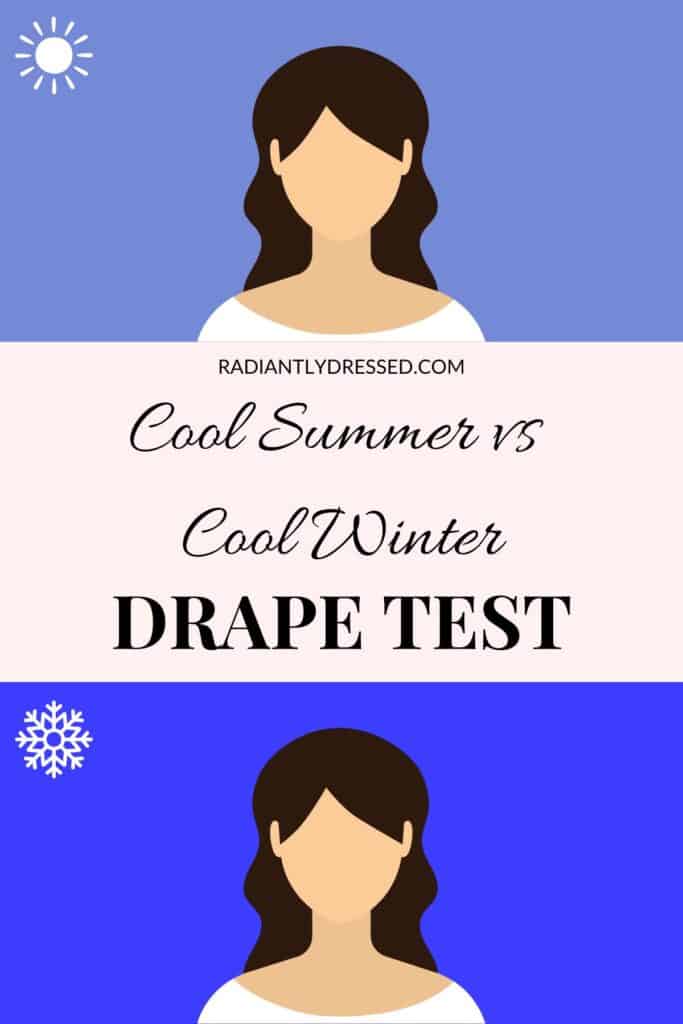
Determining Your Color Season
Discovering whether you’re a Cool Summer or a Cool Winter is not just about enhancing your style; it’s about harmonizing your wardrobe and makeup with the natural colors of your hair, eyes, and skin tone. Recognizing the differences between these two color seasons is essential, as each has a unique palette that can dramatically influence how vibrant and cohesive your appearance looks. Choosing the right season’s colors helps ensure that your outfits and makeup not only look good but also resonate with your innate coloring, allowing you to express your personal style authentically.
DIY Color Analysis
For those keen on exploring their color season from the comfort of their home, my DIY Color Analysis Course is the perfect starting point. This course empowers you with the knowledge to:
Transitioning to Professional Color Analysis
While the DIY course provides a solid foundation, transitioning to a professional color analysis can further refine your understanding of your color season.
A professional analysis offers:
- Expert Guidance: Benefit from an experienced eye that can discern subtleties in your coloring, leading to a more nuanced understanding of your season.
- Customized Palette Recommendations: Receive a personalized palette that includes detailed recommendations for clothing and makeup, ensuring every choice you make is in harmony with your natural beauty.
While there is a cost associated with professional color analysis, the investment is in yourself—yielding an individualized assessment that enhances your style, confidence, and the way you present yourself to the world.
Whether you start with DIY analysis or dive straight into professional consultation, understanding your color season—Cool Summer or Cool Winter—is a transformative step towards embracing your authentic self and showcasing your inherent beauty with every outfit and makeup choice.
Tired of going round in circles trying to figure out your color season? Hack the same process used by professional color analysts to figure out your season from the comfort of your home, and stop feeling confused about color analysis with Personal Prism.
FAQ
What are the main differences between Cool Summer and Cool Winter?
The key differences between the two color seasons lie in saturation and value. Cool Winter has a palette with more saturated and darker hues, indicative of a higher contrast appearance. Cool Summer’s palette, however, leans towards lighter and less intense colors, suitable for a more muted look.
How can I determine if I’m a Cool Summer or Cool Winter color season?
To determine if you are a Cool Summer or Cool Winter, look at the undertones of your skin, eye color, and natural hair color. Cool Summers usually have softer and lighter features, while Cool Winters typically have a higher contrast between their features, such as dark hair against light skin.
Can I wear black if I am a Cool Summer?
Cool Summer individuals may find black too harsh, as their coloring is more complimented by softer alternatives like navy or charcoal. However, they can incorporate black in small doses or as part of a pattern to avoid overwhelming their natural palette. They can also maintain black for bottoms or shoes as it tends to work well with most other colors and it’s easy to find.
Why do some colors look good on me but don’t seem to fit my season?
Color compatibility can extend beyond the prescribed palettes of your season, reflecting the unique variances in individual complexions. It’s crucial to prioritize confidence and personal affinity for colors, sometimes even stepping outside your season’s guidelines to embrace what truly resonates with you.
Is it necessary to stick strictly to my color season’s palette?
While your color season offers a guide to optimize your natural beauty, personal style and expression hold value. Experimenting with and incorporating colors outside your designated palette is a personal choice that can add depth and personality to your wardrobe.
How does knowing my color season benefit me?
Recognizing your color season simplifies wardrobe decisions, ensuring that your clothing choices consistently flatter your natural appearance. This knowledge not only boosts confidence but also streamlines shopping, aiding in the creation of a cohesive and versatile wardrobe.
Can my color season change over time?
While your skin’s undertone and the foundation of your color season remain constant, factors such as changes in hair color, lifestyle shifts, or evolving personal preferences can influence how you engage with your color season, possibly leading you to adapt your palette accordingly.
Final Thoughts on Cool Summer vs Cool Winter
Embracing your true color season—whether Cool Summer or Cool Winter—is a transformative step towards harmonizing your external appearance with your intrinsic beauty. By identifying and incorporating the colors that naturally complement your skin tone, eye color, and hair, you ensure that every outfit not only enhances your features but also boosts your confidence. This alignment allows you to express yourself authentically, showcasing a style that is uniquely yours and consistently flattering.
Armed with the knowledge of whether you are a Cool Summer or a Cool Winter, you can make informed choices about your wardrobe, makeup, and even accessories. This doesn’t just simplify shopping and dressing decisions; it empowers you to feel more put together and confident in your everyday life. As you continue to explore and experiment within your color palette, you’ll find that dressing well and feeling great becomes effortlessly intertwined with your personal style journey.
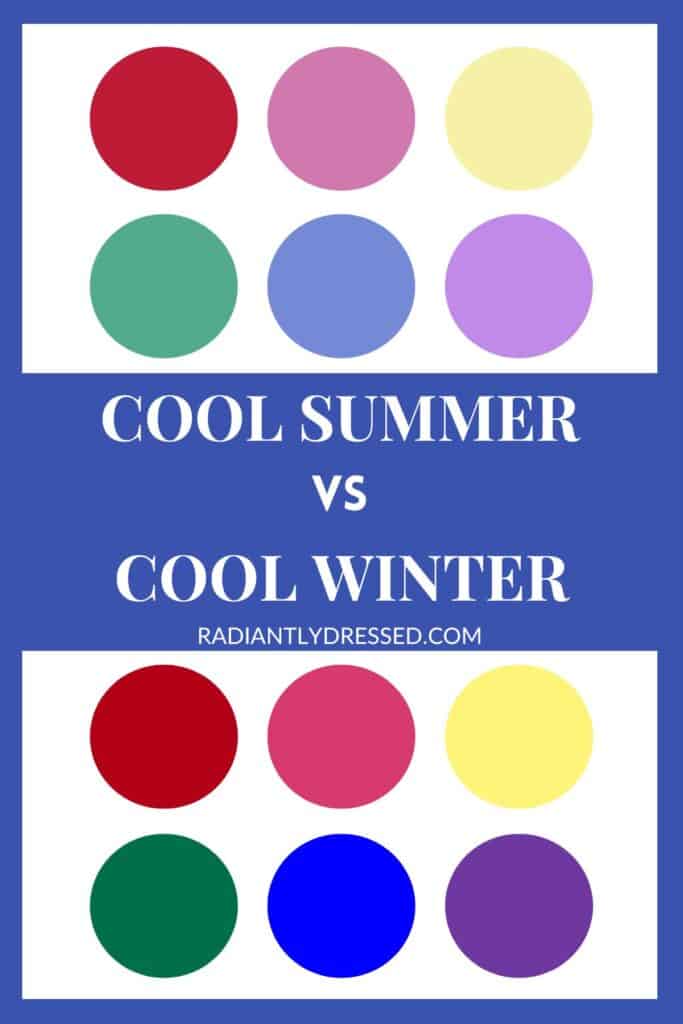
Cool Summer and Cool Winter differ in their value and contrast, and you can distinguish between them by testing these areas.
Stacey is the owner and creator behind Radiantly Dressed. She is a certified image consultant and AICI member focusing on creating simplicity in wardrobes via color and style.


